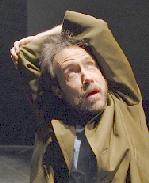SITE GUIDE
SEARCH
REVIEWS
FEATURES
NEWS
Etcetera and
Short Term Listings
LISTINGS
Broadway
Off-Broadway
NYC Restaurants
BOOKS and CDs
OTHER PLACES
Berkshires
London
California
New Jersey
DC
Philadelphia
Elsewhere
QUOTES
TKTS
PLAYWRIGHTS' ALBUMS
LETTERS TO EDITOR
FILM
LINKS
MISCELLANEOUS
Free Updates
Masthead
Writing for Us
A CurtainUp Review
No End of Blame
By Brad Bradley
|
The cartoon . . .is a liberating instrument [that] changes the world.— Bela, after also calling the cartoon 'the lowest art form.'
|

Alex Draper in No End of Blame
|
Barker's time span is primarily the early 20th century, although the events cover 1918 all the way to 1973 and the action moves from a World War I setting in the Carpathian Mountains to Budapest, and later to both Moscow during the burgeoning of communism and London during both World War II and the cold war. The center of the play is Bela Veracek, a Hungarian political cartoonist who has a strongly critical perspective on world events. Bela is constantly at odds with governments, and lampoons them in the leftist newspapers he signs on with. Of course he runs into censorship, usually imposed by his bosses after they have received similar pressure from governmental forces.
The delicately toned production by the Potomac Theatre Project builds its power throughout the performance, and delivers Barker's ambitious and thoughtful script with considerable effectiveness. At the center is leading actor Alex Draper, who conveys a perfect combination of artistic inquisitiveness and social bafflement to register Bela's international journey as an artist struggling to exhibit his freedom of expression. In his youth, even before he considers satire or political criticism, he finds himself with an artist's perspective near the First World War battlefield when he sees a naked woman. While others see her as a potential object of rape, he instead concentrates on her physical form, seeing her instead as a model for his pencil drawings, having generally been limited to soldiers in uniform as his unwitting models.
Later, just out of art school, Bela describes artists as those who "thrill to beauty." At that time, all he wants is "a little corner where I can paint." In Moscow, when he receives praise from Lenin for being an artist "that is not bourgeois," he describes his cartoon as "the lowest form of art," yet also"the most important form of art. . .The cartoon . . .is a liberating instrument [that] changes the world."
In a late scene, set in a London newspaper office in 1973, Bela has become an urbane version of the tramps of Beckett's Waiting for Godot. After traveling through 55 years and several countries, his pressured and frustrated boss tells him that "feelings exist," an indirect way of saying that his work has become too negative and therefore undesirable.
The many scenes fluidly connect in Richard Romagnoli's deft direction, with appropriate (strangely not credited) music between them that evokes a mood that on the one hand is calming and on the other potentially explosive. All in the marvelous cast of 13 but Mr. Draper have multiple roles, and they delineate them so effectively that they collectively create the impression that there are 25 or more using the stage. In a couple of scenes, floor action creates poor sightlines, but otherwise, the play is wonderfully assembled for the fascinating and often provocative impact on the audience that Barker apparently intended. Minimal sets and vivid projections (mostly of cartoon examples) enhance the production while keeping the script in focus.
The play's serious exploration of the negative social fallout in the modern world happily is punctuated by significant moments of humor, notably an artist's model behaving as a stand-up comic, a bureaucrat's obsequious posturing, and a hilarious scene involving British cabinet ministers getting edgy because their tea tray has not arrived on schedule.
|
No End of Blame
Written by Howard Barker (In repertory with Politics of Passion- 3 plays by Anthony Minghella). Directed by Richard Romagnoli Cast: Alex Draper, Christopher Duva, Megan Byrne, Alex Cranmer, Jeanne LaSala, Peter Schmitz, Bill Army, Alec Strum, Caitlin Dennis, MacLeod Andrews, Julia Proctor, Sally Swallow, and Lucas Kavner Set Design: Aaron Gensler Lighting and Projections Design: Hallie Zieselman Costume Design: Catherine Vigne Running time: 2 hours, 15 minutes including intermission. Potomac Theatre Project at Atlantic Stage 2, 330 West 16th Street. www.potomoactheatreproject.org From 6/20/07 to 7/13/07; opening 6/27/07 Viewed by Brad Bradley June 27th |
Try onlineseats.com for great seats to
Wicked
Jersey Boys
The Little Mermaid
Lion King
Shrek The Musical

Easy-on-the budget super gift for yourself and your musical loving friends. Tons of gorgeous pictures.

Leonard Maltin's 2007 Movie Guide

At This Theater
Leonard Maltin's 2005 Movie Guide

 >
>

Wicked
Jersey Boys
The Little Mermaid
Lion King
Shrek The Musical

Easy-on-the budget super gift for yourself and your musical loving friends. Tons of gorgeous pictures.

Leonard Maltin's 2007 Movie Guide

At This Theater
Leonard Maltin's 2005 Movie Guide

 >
>

